Compiled by Walter Sorochan
Posted September 11, 2016; Updated October 17, 2021. Disclaimer The information presented here is for informative and educational purposes only and is not intended as curative or prescriptive advice. The statements of this web-site have not been evaluated by the United States Food and Drug Administration (FDA). Nothing stated here should be considered as medical advice for dealing with a given problem, or to diagnose / treat / prevent / cure any disease.
This article attempts to provide update information about the new psychiatric approach of Dr. Daniel G. Amen in healing mental-emotional disorders and diseases.
|
Is Brain health same as mental health? My initial perception about the term "brain health" was that it was about mental health. But as I explored this term, I realized that it was about an emerging medical practice. Brain health has practical applications in helping medical doctors do a better job of diagnosing and healing mentally-emotionally disturbed patients; as well as healing other diseases. Brain health needs to overcome an image problem that is a barrier to it being accepted as a healing modality at this time! Walter Sorochan |
Western medicine treats mental-emotional disorders, like symptoms of depression and anxiety, by focusing on drug therapy; while psychiatrist Daniel Amen looks for the cause of mental-emotional disorders by scanning the brain and prescribing appropriate medications tailored to each patient. These two different approaches are turning medical therapy psychiatry and medical practice upside down; thereby evolving more resistance to Amen's approach and hence, controversy. Tucker: Amen most popular 2011 0 Amen:Spect imaging 2016
Contrary to what Hall, 'hired-gun' writer for Quackwatch Hall: Quackwatch Criticism of Amen, would have you believe, there are many researchers investigating the use of brain scans to help doctors better understand how the brain reacts to a variety of insults. You can view the ongoing research giving credibility to Amen's brain scan approach by referring to the Journal : Brain and Imaging Behavior
The illustrations below exemplify this difference:
| Medical approach | Amen approach |
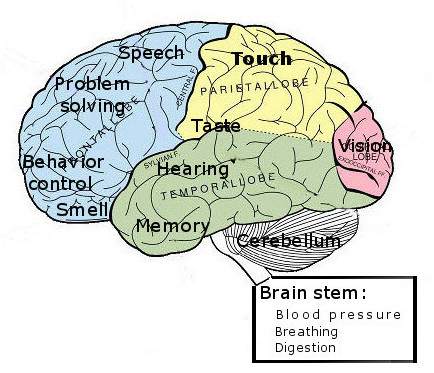 |
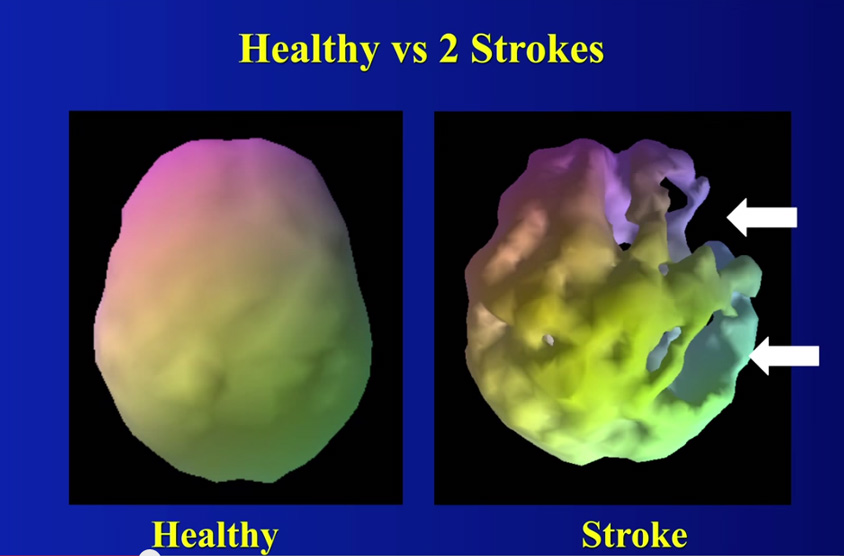 |
Medical doctors view the human brain [above illustration on the left side], located inside the skull, as the main organ of the human central nervous system and body control. Medical researchers have identified different areas of the brain with various body functions like sight, hearing and so on. Disorders related to the brain are usually interpreted by their symptoms and treated with medications. Such a traditional approach has helped our understanding of how the brain works and in many instances, such understanding has helped doctors relief patient symptoms of pain. But such an approach is different to the approach that psychiatrist Daniel Amen has taken over 30 years, in scanning over 120,000 patients from around the globe in 111 countries. He scanned the brains of healthy, sick, diseased, drug addicts, alcoholics, smokers, football injuries and others to determine the difference inside the brain as it relates to the cause and then prescribes therapy appropriate to each individual person. Two different approaches in healing mental disorders and diseases.
Dr. Daniel G. Amen, MD, America's Leading Psychiatrist & Brain Health Expert Tucker: Amen most popular 2011, has researched the inside of the brain and found:
- Psychiatric illnesses are not single or simple disorders, they all have multiple types.
- Without looking at the brain, many important pieces of information are missed, which can hurt you or someone you love.
- Yes, you can change your brain and change your life.
- Emphasis on prevention --- eating healthy foods, changing lifestyles; avoiding toxic drugs and chemicals.
Dr. Amen's view of the brain:
"A piece of brain tissue the size of a grain of sand contains 100,000 neurons and 1 billion synapses, all “talking” to one another. Information in your brain travels at about 268 miles per hour, unless of course you are drunk, then things really slow down. If you don’t take care of your brain, you lose on average 85,000 brain cells a day. That is what causes aging. With appropriate forethought, however, you can reverse that trend and dramatically slow the aging process and increase your mental agility." Amen: Healthy brain live
|
What is Brain Health Scan? Using brain imaging to find biomarkers for mental illnesses. “Change Your Brain, Change Your Life. This is single photon emission computed tomography, SPECT, a type of nuclear imaging test that measures blood flow in organs of the body. Using a radioisotope injected into the bloodstream, it illuminates a path for a camera to record the flow. The technology is commonly used to detect cardiovascular disease and cancerous tumors. In neurology, it is mainly used to research broad outlines of brain function in groups of patients. In clinical practice, doctors use it to uncover evidence of strokes, epilepsy, trauma, some types of dementia and heavy drug use. |
What is Amen's brain scan?
Amen defines his brain scan as a single photon emission computed tomography [ SPECT ] to help diagnose and manage cases of brain trauma, underachievement, school failure, depression, obsessive compulsive disorders, anxiety, aggressiveness, cognitive decline, and brain toxicity from drugs or alcohol. Hall: Quackwatch Criticism of Amen 2007
Amen claims that SPECT scanning provides “guidance in the application of specific medications or other treatments." Hall: Quackwatch Criticism of Amen 2007 Amen:Spect imaging 2016
SPECT . . . . "basically tells us three things: areas of the brain that work well, areas of the brain that work too hard and areas of the brain that do not work hard enough. Once we know how the brain works, the goal of treatment is to balance brain function, such as calm the overactive areas and enhance the underactive ones."
"SPECT creates a colored picture representing blood flow or chemical reactions in different areas of the brain. It requires the injection of a radioactive material. Areas of low blood flow show up as apparent “holes” on colored pictures of the brain, giving a moth-eaten appearance. Amen says that when patients improve clinically, the appearance of their follow-up scan typically improves. For example, patients using marijuana had areas of low activity in the temporal lobes compared to patients not using the drug. Dr. Amen says he can literally show his patients “this is what your brain looks like on drugs.” In one case he reported, a patient with attention deficit disorder, obsessive thinking, anger outbursts, and depression had demonstrable defects on the initial scan which were visibly improved after three years of clomipramine therapy. Dr. Amen says that this kind of graphic demonstration can help persuade patients that their problem is physical or physiological and might be helped with medication or other treatments." Hall: Quackwatch Criticism of Amen 2007
"Add SPECT to the list of imaging modalities that can help physicians distinguish between post-traumatic stress disorder (PTSD) and traumatic brain injury (TBI), potentially leading to more appropriate treatment for military veterans." Forrest: UCLA study of PTSD scans 2015
Brain Food:
"The brain uses up to 20 to 30 percent of the calories you consume. And, just like your body doesn’t benefit from junk food, neither does your brain. One lesser-known fact about obesity is that it negatively impacts cognitive function. If you want to look your best, feel your best, and do your best thinking, you have to give your brain high-quality nutrition."
Avoid eating highly processed foods, laden with sugar, bad fats, and salt; made from ingredients grown with pesticides; flavored with artificial sweeteners; colored with artificial dyes; and preserved with artificial preservatives.
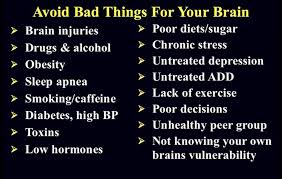
Cost of Amen Scan:
"The Amen Clinics charge $3,250 for a "comprehensive evaluation," which includes the patient's history, two SPECT scans (concentration scan and baseline scan), a physician consultation, and a 30-minute treatment follow-up appointment. Follow-up scans after treatment are $795 each." Hall: Quackwatch Criticism of Amen 2007 Commentary: This cost for a single patient is too expensive! This type of scan is not covered by insurance companies!
You can take Dr. Amen's Brain Health Assessment online and find out which of the 16 brain types you have..
A few of Amen's brain Scans: [ compare each scan to a healthy normal brain ] Amen points out that each scan picture represents blood flow or chemical reactions in different areas of the brain. The moth like holes in the brain images reflect the disruption of blood flow.
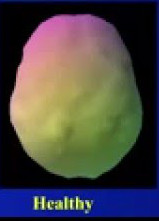 |
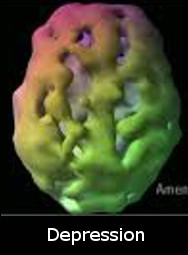 |
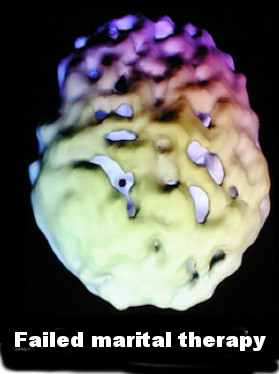 |
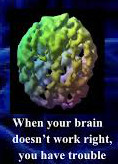 |
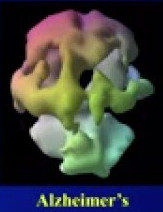 |
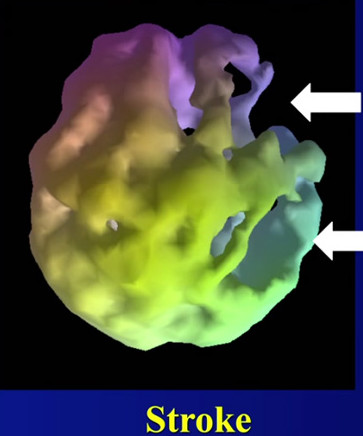 |
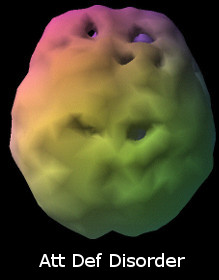 |
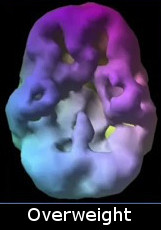 |
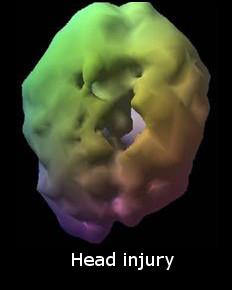 |
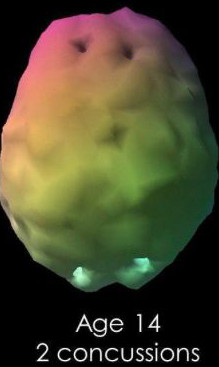 |
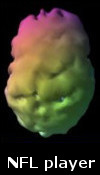 |
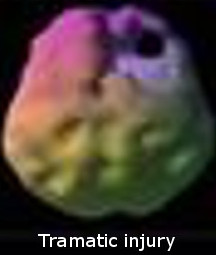 |
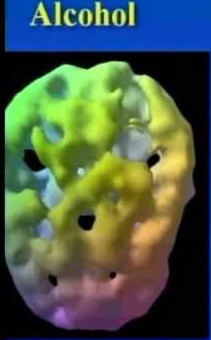 |
 |
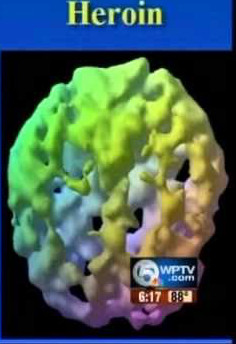 |
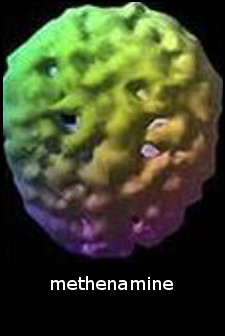 |
Interpreting brain scans [Example]:
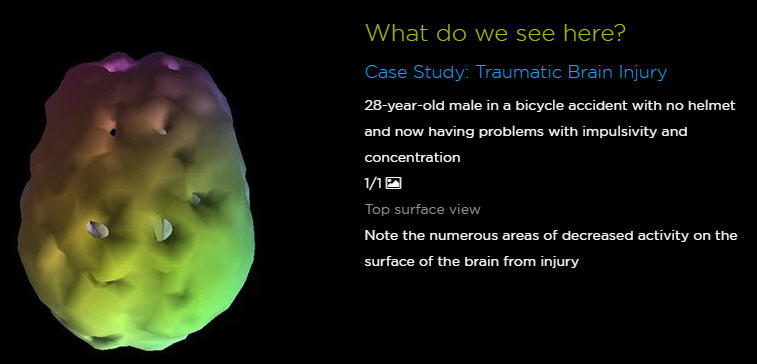
Different views & types of brain scans for same disorder:
Brains of persons with the same disorder work differently. This is illustrated [below right] for those diagnosed with Attention Deficit Disorders [ADD]:
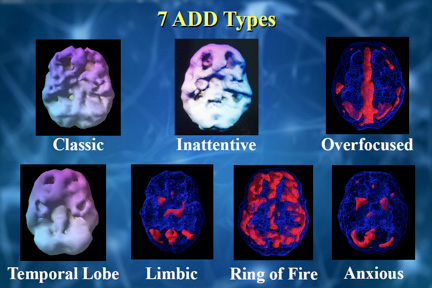 ADD
Brains Work Differently! Ideally, when we concentrate, blood flow
should increase in the brain, especially in the prefrontal cortex; this
increased activity allows us to focus, stay on task and think ahead. In
the brains of most people with ADD, blood flow actually goes down when
they concentrate, making it harder to stay focused. In other words, the
harder they try, the harder it gets! ADD, like many other conditions, is
not just a single and simple disorder; therefore, treatment is not a
one-size-fits-all solution. We, at Amen Clinics, have identified 7 types
of ADD—and each requires a different treatment plan because of the
diverse brain systems involved.
Amen: helping ADD 2016
ADD
Brains Work Differently! Ideally, when we concentrate, blood flow
should increase in the brain, especially in the prefrontal cortex; this
increased activity allows us to focus, stay on task and think ahead. In
the brains of most people with ADD, blood flow actually goes down when
they concentrate, making it harder to stay focused. In other words, the
harder they try, the harder it gets! ADD, like many other conditions, is
not just a single and simple disorder; therefore, treatment is not a
one-size-fits-all solution. We, at Amen Clinics, have identified 7 types
of ADD—and each requires a different treatment plan because of the
diverse brain systems involved.
Amen: helping ADD 2016
Where can you get a brain scan?
Locations of Amen Clinics: 2016 --- Costa Mesa Ca; San Francisco Ca; Reston Ca; Brisbane Ca; Bellevue Wa; Atlanta Ga; New York NY..
Conclusion:
Although Amen's approach is revolutionary and counter to current medical-psychiatric practice, Amen's brain health approach should not be ignored. Brain health approach could easily be viewed as a Starwar's magic healing process that is in its infancy.
As with all new innovations, there is controversy and this one is no different. But since medical practice has not been too successful in treating emotional-mental illnesses or keeping people health, we should have an open mind about Amen's approach.
Yes, although Amen's approach appears to lack traditional adequate evidence-based, scientific evidence, one cannot deny that Amen has healed many of his patients .... something that many psychiatrists and medical doctors have failed to do! Burton: TV controvery 2008 Amen:Spect imaging 2016
The key issue about emotional-mental issues like Amen's approach is not whether this approach is good or bad, but that it has promise in resolving many of the current failing medical and public health approaches in dealing with mental-emotional problems. For example, the state of mental health in United States has been getting worse since 1960 [ since we closed mental health clinics ]! Today, the state of mental wellbeing in United States is deplorable! War veterans suffering from shell shock; the thousands of homeless; mentally ill persons on city streets; the drug user crisis; millions with depression and anxiety; violent behaviors; and others with related emotional illnesses [ those in prisons ] are not being rehabilitated. Furthermore, medical doctors, public health and congress are not dealing effectively with these ignored problems. And yes, congress has passed a lot of bad legislation that favors companies making money instead of protecting the health of people. We need to look for better solutions.
So it is reasonable and acceptable to look elsewhere for such solutions. Amen and his researchers recommend use of brain scanning technique in medical clinics [ this would require medical doctors and psychiatrists to acquire a brain scanning skill set ]. Amen's approach offers a spark of hope! Amen:Spect imaging 2016
One should expect psychiatrists like MD, Robert Burton, to agree with Quackwatch critics and defend his turf! Burton: TV controvery 2008
Time is on our side and will eventually resolve the controversy and skepticism. Amen:Spect imaging 2016
So.... is Amen's perception of healing the brain for optimal wellbeing real and good? This independent research-author has provided referenced information to help make you better informed! You be the judge on this issue!
References:
Amen Daniel G., "19 Best Brain Superfoods," Amen Clinics, August 13, 2013. Article no longer active.
Amen Daniel G , Manuel Trujillo, Andrew Newberg, Kristen Willeumier, Robert Tarzwell, Joseph C Wu, Barry Chaitin, "Brain SPECT Imaging in Complex Psychiatric Cases: An Evidence-Based, Underutilized Tool," Betham Open - The Open Neuroimaging Journal, Volume 10, 2016. Amen:Spect imaging 2016
Burton Robert, "Brain scam - Why is PBS airing Dr. Daniel Amen's self-produced infomercial for the prevention of Alzheimer's disease? Salon, May 12, 2008. Burton: TV controvery 2008
Forrest Wayne, "SPECT differentiates PTSD from TBI in military veterans," AuntMinnie.com, May 11, 2015. Forrest: UCLA study of PTSD scans 2015
Hall Harriet, "Dr. Daniel Amen's Response to Criticism on Quackwatch," Quackwatch, November 12, 2007. Hall: Quackwatch Criticism of Amen 2007
Hall Harriet, "A Skeptical View of SPECT Scans and Dr. Daniel Amen," Quackwatch, 2007. Hall: Skeptical of scans 2007
Tucker Neely, "Daniel Amen is the most popular psychiatrist in America. To most researchers and scientists, that’s a very bad thing," The Washington Post, August 9, 2012. Tucker: Amen most popular 2011